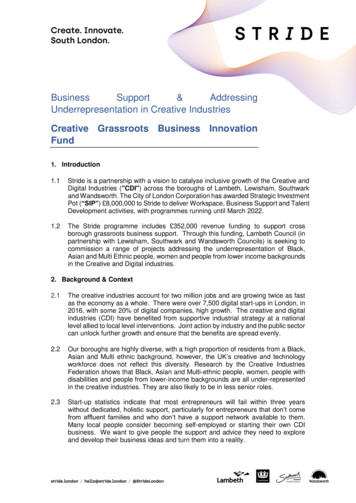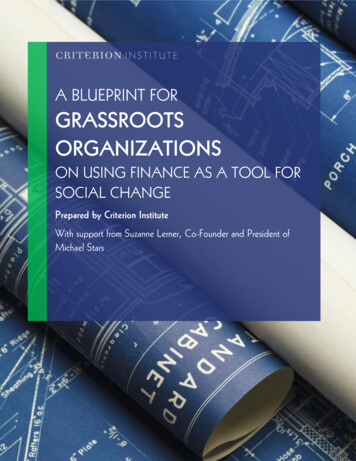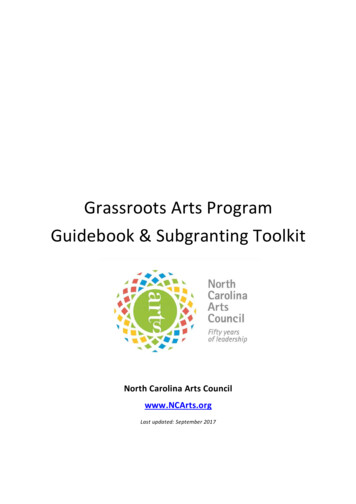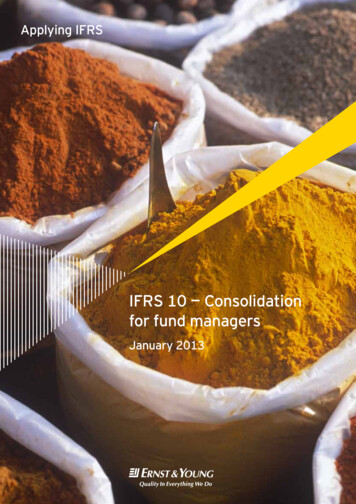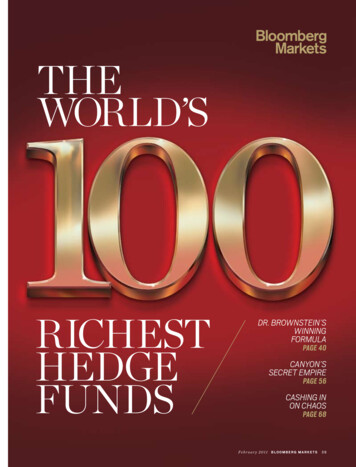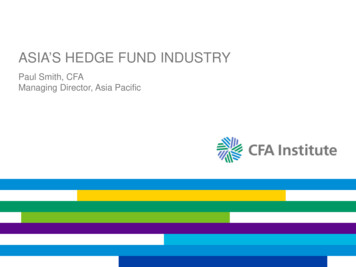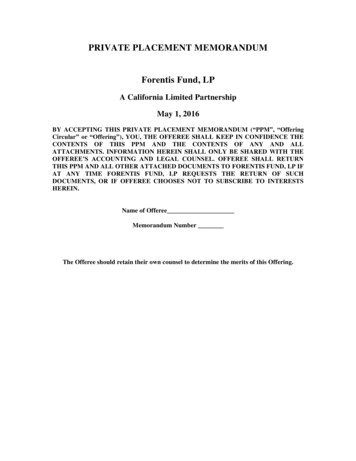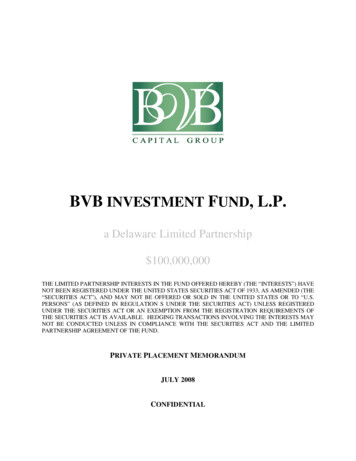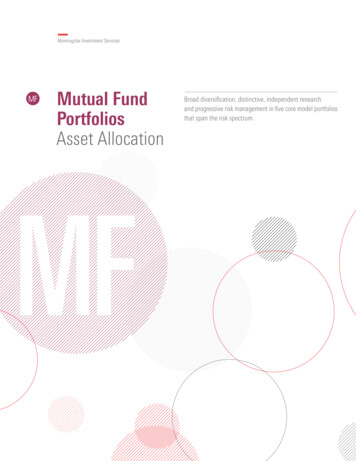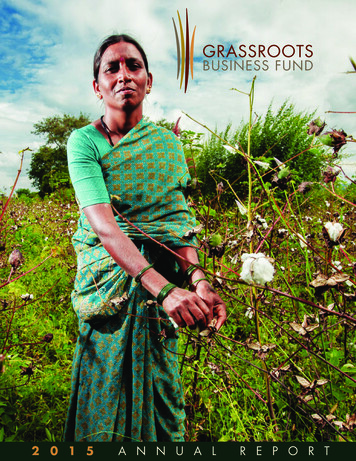
Transcription
GRASSROOTSBUSINESS FUNDGrassroots Business Fund Annual Report 201520 1 5A N N U A LR E P O R iT
Table of ContentsPage 1: Letter from CEO and Chairman of the BoardPage 3: About UsPage 4: Our PerformancePage 5: Social ImpactPage 6: AgribusinessPage 7: ArtisanalPage 8: Products and ServicesPage 9: GBF TeamPage 10: Governing Board and AdvisorsPage 12: Financial StatementsGrassroots Business Fund Annual Report 2015ii
GRASSROOTSBUSINESS FUNDDear Friends,We are pleased to present GBF’s Annual Report for Financial Year 2015, ending June 30, 2015.A key pillar of GBF’s work is to stay developmentally useful—taking appropriate risks and doing hard,but valuable, work. Investing in socially impactful projects, we continue to work in challenging sectorswith a focus on agribusiness and in regions that have been difficult for others to reach. We believe GBF’smodel is a potentially an important one for the field—building companies, encouraging professionalismand formalization as well as striking better models for blending of investment capital and business advisoryservices. GBF has shown its ability to adapt to learnings as well as changes in our environment.The past year was one of maturation and continued improvement for GBF. We advanced significantlyin decentralizing the organization—including the budget, and people and resources—from HQ to ourfield offices. Our local offices now lead on key parts of our business, and are even taking on key globalmanagement functions.Results so far are encouraging, with each dollar invested in our portfolio companies estimated to provide 4of economic value to our targeted low income communities. These companies are growing 20% annuallyon average, and have supported over 540,000 sustainable jobs for farmers, workers and artisans over thepast fiscal year.We have undergone several evaluations, and the outputs from these have provided inputs for furtherimprovements to our model, such as streamlining processes and increasing efficiencies.Staff is a key part of our model, and we are making progress in retaining and developing our key personnel.We have upgraded our staff and brought in better advice from consultants (mostly local), mentors (experiencedlocal businesspeople), and GBF stakeholders (investors and Investment Committee members). This is helpingus learn, grow and make better decisions, and provide better input to our investees. We think we are on theright track. Challenges remain, but we are energized by the journey, advancing toward our goal of a biggerand better GBF - one that creates lasting social impact on large numbers of the poor.Sincerely,Harold RosenChief Executive OfficerAndrew AdelsonChairman of the BoardGrassroots Business Fund Annual Report 20151
About UsThe Grassroots Business Fund (GBF) aims to reduce poverty by building companies which provide sustainable incomesand cost-savings for poor populations in lower-income countries. GBF’s market-based approach to poverty alleviationfocuses on building “High Impact Businesses” (HIBs)—firms which benefit large numbers of the poor by generatingincome or offering affordable, quality products and services. Through a network of mostly field based investment andbusiness professionals, GBF grows HIBs in two ways:By providing tailored investment capital using a high-touch approach that itself helps build companies’ businessfundamentals, andProviding investees with “Business Advisory Services” (BAS), which connect companies to local industry experts.GBF’s experienced staff has built and refined this model for over a decade, based on direct, on-the-ground experience,investing in over 60 businesses in Africa, Asia, and Latin America.Our History:Following four years of incubation in the World Bank’s International Finance Corporation, GBF became an independentnon-profit organization in 2008.200820112016GBF 1.0Spin off from IFC 20M(100% grants)GBF 2.0Launch Private Investment Fund 55M(20% grants, 80% investment)Proposed GBF 3.0Launch Private Investment Company 120M over 5 years(5-10% grants)GBP – Non Profit Grant Management Investment Management Investing Staff Provided BAS Consultants provided BASGBP – Non Profit Donor Management Staff Provided BAS Consultants provided BASGBP – Non Profit Consultant-provided BAS Donor ManagementGBI-I – Private Investment Fund Investing Limitedlife fund (10 years)Grassroots Business Fund Annual Report 2015New Investment Company “Evergreen” structure Intense Investee “hand-holding”2
Our PerformanceGBF Investment Fund Performance1Among small and medium enterprises in developing economies, 25% of firms cite access to finance as a majorconstraint, and 50% are unserved or underserved.2 We try to help businesses access financing that meets their needsand alleviates their constraints. Experience with our investees suggests that GBF’s model can work to help companiesgrow into sustainable, profitable sources of value in their communities. Our fund is on track to provide financial andsocial returns in line with original expectations.Key Performance IndicatorActuals (as of June 30, 2015)Approved Investments 38M% of Approved Portfolio Disbursed84%Number of Investee Companies30Active Portfolio Valuation 24.4MNumber of Active Investee Companies19Active Portfolio Internal Rate of Return8.6%Investment by IndustryOther 7%21%avg. investeerevenue growth90%of positive investeeshave postive EBIDTAInvestment by RegionSoutheast Asia 13%Artisanal 22%South Asia 21%Latin America 52%Agribusiness 71%Africa 14%1 See page 12 for GBF’s financial statements for the fiscal year ending 6/30/152 World Bank Group International Finance Corporation, Enterprise Finance Gap DatabaseGrassroots Business Fund Annual Report 20153
BAS PerformanceGBF’s BAS program provides advisory services to portfolio companies (or far along pipeline companies) of GBF’sinvestment fund GBI-I in order to support their growth and sustainability improving business skills. The assistanceoffered by BAS serves to underpin capital provided by GBF.Core BAS Areas: After 2 years in the portfolio Financial ManagementOver 73% of the companies had a financialdashboard in place that is regularlyreviewed: Only 17% had one in 2012Strategy100% of companies have a writtenlong term strategy and discuss itsimplementation, compared to 73% in 2012OperationsOver 78% of companies have diversifiedbuyers and suppliers and actively managerisk through diversification: 55% in 2012CorporAte GovernanceOver 89% have competent managers inplace who could take over for CEO: 64%in 2012Legal/Regulator78% of companies are organized in amanner enables outside investment: 45% in2012Environment & Social Management100% of companies have a functionalhuman resources policy in place foremployees: 75% in 2012BAS Figures3 4.3M 149Mspent onBAS activities7584102,100,000delivered totarget beneficiariesHIBssupportedemployees supportedby these HIBsdirectbeneficiaries4BAS Review: Mid-Term ReportGBF commissioned an independent financial consultant to conduct a review of our BAS program, completed on April20, 2015. While offering suggestions to streamline BAS delivery, encouraging decentralization, better transparencyand an overhaul of the organization’s evaluation system, the review contends that GBF’s blended-finance approachis distinctively impactful, helping create profitable and sustainable companies that improve the lives of employeesand their dependents.The author specifically pointed to GBF’s willingness to provide pre-investment technical assistance. Many organizationsshy away from assistance before any official commitment. GBF’s willingness, however, begins the client partnershipon an important note: GBF isn’t just in the space to collect loan repayment checks, but to engage deeply with clients.3 Cumulative since 20114 New farmer, artisans, entrepreneurs, and BoP consumersGrassroots Business Fund Annual Report 20154
Social ImpactIn an attempt to quantify the economic impact of its investees, GBF measures two key indicators for its companies:economic value generated as income or cost-savings, and the number of people affected. GBF considers only aportion of payments to producers as income, to account for net benefit, after deducting beneficiaries’ production costsand/or economic alternatives. Accounting for economic realities, we try to capture both income and cost-savingsincrementally—expressing the additional benefits that GBF investees offer local communities compared to existingopportunities.Investment TypeIndividualsDirectly SupportedIncome to Farmers and Workersfrom GBF InvesteeAgribusiness29,227 39.6MArtisanal51,089 36.3MProducts & Services1,829,184 55.7MActive Fund Total1,909,500 131.6MGBF also calculates an Economic Rate of Return for each investee, projecting economic flows to key stakeholderslong-term. When feasible, social impact surveys help GBF adjust assumptions and better understand its beneficiarygroups.As a responsible business partner, GBF also helps companies promote sustainable, responsible practices. Environmentaland Social Management (E&S) Programs for each investment screen out companies with unsuitable practices or inpotentially harmful industries, while each investee receives assistance developing and executing action plans to limitany adverse environmental impact and promote social responsibility. As part of our BAS programs, GBF helps clientsfund E&S programs and sets realistic, measurable targets.In the past year, GBP has focused on social impact research, including quantitative measurement as well as indepth interviews with employees and farmers involved with our clients. For the latter, we met with stakeholdersfrom CAVSAC, Villa Andina and Novica in Peru. In 62 hours of interviews, our key takeaways were: Our BAS and client technical assistance is highly valued The price and payment guarantees our clients offer are important to the end beneficiary All 3 of the companies offered significant employment for women, and all those at the base of the economicpyramid, i.e. our intended beneficiariesGrassroots Business Fund Annual Report 20155
AgribusinessFor the rural poor, improvements in agriculture can play a transformative role.By improving rural conditions, agricultural development can reduce poverty andmigration or changes in livelihood. From 1993 to 2002, more than 80% of thedecline in rural poverty was attributable to better rural conditions, as opposed tomigration.5 The World Bank’s 2013 World Development Report noted agriculturecontinues to face challenges in financing, logistics, and encouraging technologicalinnovation.6 However, as the global food industry modernizes, SME agribusinessescan help smallholder farmers secure and fulfill lucrative contracts for specialtyproducts. Such coordinated supply chains can increase farmer incomes by 10 to100 percent.75 World Bank, World Development Report, 2008, p.36 World Bank, World Development Report, 2013, p.1927 World Bank, World Development Report, 2008, p.12770%of portfolio 20.3Mcommitted in FY15136,800people/dependentssupportedClient Spotlight: Villa AndinaVilla Andina, (VA) is an agribusiness in Cajamarca, Peru, whichexports organic dehydrated fruits (aguaymanto (golden berry) andmango), other Andean products such as maca, quinoa and cacaonibs. VA buys the products from over 500 low income, small-scalefarmers, processes them at the plant, and sells them in local andinternational markets.With the help of GBF’s BAS programs, VA is improving corefunctions, including financial management, operations andcorporate governance. Villa Andina has generated 2.1M ineconomic impact for its suppliers and employees since 2012. VAhas a strong relationship with its farmers, thanks to its supplierdevelopment program that has helped farmers improve theirproduction practices.Most of the farmers are based in communities in and aroundCajamarca. By working with VA, farmers gain access to a fixedprice and a stable market, receiving consistent income and technicalassistance in organic agricultural processesGrassroots Business Fund Annual Report 20156
Artisanal SectorEven though artisanal work is the second largest source of employment in the developingworld, artisans often lack the connections or know-how to acquire funding, expand, orconnect with global communities. Many artisans practice crafts that have been aroundfor centuries, and are inherently tied to their homeland. Whether it is weaving, painting,or other types of handiwork, artisans are vital for cultural preservation. Traditionallymarginalized groups, including a disproportionate share of women, comprise many ofthe workers in the artisanal sector, making it a great avenue for empowering women andthose at the bottom of the economic pyramid. 34 Billion661023%of portfolio 6.8Mcommitted in FY15est. global market value8percent of world’s workdone by womenpercent of world incomeearned by women8 ple/dependentssupportedClient Spotlight: Jaipur RugsWith its mission to “Service the Community,” Jaipur RugsCompany (JRC) is one of the largest and most distinguishedsocial enterprises in India. Headquartered in Jaipur, India,JRC was founded by N. K. Chaudhary in 1978 with only twolooms. JRC provides special loans to their artisans, allowingthem to work in their own homes, eliminating the middle manand providing a space for the disadvantaged to financiallyempower their lives on their own terms.After GBF’s investment in 2012, JRC’s total revenues increasedat an annualized rate of 35% while generating positive EBITDAand PAT margins every year. Since then, JRC’s operationshave grown to support over 30,000 low-income, home-basedweavers and wool spinners, up from 12,000 artisans at thetime of investment - a 2.4x increase. Our social impact surveyrevealed that women comprise 59% of JRC’s workforce. Thesurvey also found 92% of the workforce is from socially andeducationally disadvantaged classes and minorities in India.Grassroots Business Fund Annual Report 20157
Products and ServicesCompanies that GBF supports in this category are High Impact Businesses that provideproducts or services to the poor in their regions. This could be providing affordablecoffee and grain production equipment, clean cook stoves, or environmentally friendlybuilding materials. P&S companies are interesting to GBF because they improve the livesof the low income consumers.This improvement can come in various ways. It can come in the form of cheaper goods,provided by increased competition in the market or innovation by a company. It canrepresent a positive boon to the community or environment. For example, Skepl (Gujrat,India) provides quality control for milk, helping both farmers and consumers, while TaraMachines (New Delhi) specializes in affordable green building materials. Partneringwith these businesses helps the economy, employees and their beneficiaries, as well asconsumers and their community at large.7%of portfolio 2.1Mcommitted in FY154.67Mpeople/dependentssupportedClient Spotlight: BrazAfricEstablished in Kenya in 1994, BrazAfric is an agriculturalequipment company operating in 6 African countries.BrazAfric sells products and equipment sourced predominantlyfrom Brazil but also from India. BrazAfric has three servicedivisions: coffee, grain, and non-agricultural trade.BrazAfric reaches over 298,000 farming families, over90% of which are estimated to be lower-income households.The installation of dry mills by cooperatives has optimizedefficiency and increased farmer income by an estimated1.8%.BrazAfric has developed a reputation in the region forsupplying economical and reliable machinery. They supportthis claim with a commitment to after-sale customer service,focusing on client satisfaction by continually ensuring theproducts work correctly. Secondly, the dry mills are widelyused across the industry even in some older millers. Lastly,the proximity of the mills to the farmers reduces transportationcosts, increasing their income as well as the quantity of highquality beans milled.Grassroots Business Fund Annual Report 20158
GBF TeamWashington, DCNairobi, KenyaHarold Rosen, Chief Executive OfficerLilian Mramba, Africa Regional DirectorJaime Ramirez, Chief Investment OfficerAmos Gichinga, Senior Investment OfficerRebekah Plotkin, Vice President of Finance &AdministrationNoel Wadaki, Operations Manager & BAS CoodinatorRose Galamgam, Finance OfficerZoya Aleem, Global Portfolio AnalystNeil Christy, Communications & Executive Assistant(formerly)Laila Kassam, Office AssistantNew Delhi, IndiaVikram Raman, India Country ManagerDaniel Kolender, Operations Assistant & CommunicationsVijay Chandrashekar, India Portfolio ManagerDaniel Shemesh, Fundraising & Executive AssistantSaurabh Lahoti, Investment OfficerSahiba Chauhan, Senior Investment AnalystLima, PeruKaran Sawhney, Senior Investment AnalystNatasha Barantseva, Latin America Regional DirectorJulio Ayca, Latin America Portfolio ManagerMiguel Tamayo, Investment OfficerMayra Ramirez, Office Manager & BAS CoordinatorOlga Egorova, Investment AnalystWashington, DCNew DelhiNairobiLimaGrassroots Business Fund Annual Report 20159
Governing Board and AdvisorsBoard:Andrew Adelson, Chairman, Former Chief InvestmentOfficer, Alliance BernsteinMary Houghton, Co-Founder, Shorebank CorporationStephen Brenninkmeijer, Willows InvestmentsMwaghazi Mwachofi, General Manager, Aga KhanAgency for Microfinance (AKAM)Zoë Dean-Smith, Senior Director of Global Programs,Vital VoicesHarold Rosen, Chief Executive Officer, GrassrootsBusiness FundGuillermo Ferreyros, Chief Executive Office, President,and Executive Director, Maple Energy PLCHolly Wise, Wise Solutions LLCGBF Advisors:Andrew Adelson, Investment Committee member, BASSteering Committee memberAnnette Berendsen, Fund Advisory Committee memberSari Miller, GBF AdvisorDeborah Moronese, Fund Advisory Committee memberAlan Patricof, GBF AdvisorStephen Brenninkmeijer, Fund Advisory CommitteememberHelmut Paul, Investment Committee memberRafael Guillermo Ferreyros Cannock, InvestmentCommittee member, GBF AdvisorK.K. Rathi, GBF Advisor Investment Committee Member(India)Kristin Duchâteau, BAS Steering Committee memberSir David Scholey, GBF AdvisorLeah Mburu, GBF Africa BAS Portfolio CFO, GBF AdvisorJoachim Schwenke, GBF AdvisorPradeep Kapse, GBF AdvisorRoel Vriezen, BAS Steering Committee memberThomas Klein, Fund Advisory Committee memberHolly Wise, BAS Steering Committee memberSerge Kremer, Investment Committee memberJim Wolfensohn, GBF AdvisorAnnette Berendesen, Fund Advisory Committee memberElaine Wolfensohn, GBF AdvisorPramod Gothi, GBF AdvisorClaus-Peter Zeitinger, GBF AdvisorGrassroots Business Fund Annual Report 201510
Donors to the NonprofitThe Dutch Ministry of Foreign Affairs (funding managedby FMO)Government of Canada (funding managed by IFC)NORAD- The Norwegian Agency for DevelopmentCooperationOeEB- Development Bank of AustriaOmidyar Network*Arnold & PorterAdelson Family FoundationStephen Brenninkmeijer*Charly & Lisa Kleissner (KL Felicitas Foundation)*Harold Rosen and Susan WedlanPercy Barevik*Mark Cohen*George Rohr*Mason Haupt*Lee Spelman Doty*Seizen Foundation*Luxembourg Ministry of Finance*Cordes Foundation*Indicates a major contributor in prior yearsInvestors in the FundOverseas Private Investment CorporationChary and Lisa Kleissner (KL Felicitas Foundation)Calvert Social Investment FoundationSerge KremerDeutsche Bank Americans FoundationLuxembourg Ministry of FinanceDEG- German Development BankLeah and Jeffrey KronthalFMO (The Netherlands Development Finance Company)Sudhir and Sangeeta Maheshwari (AIM to ZEROFoundation)Andrew Adelson (Adelson Family Foundation)Judson BerkeySuzanne Biegel and Daniel MaskitPeter Braffman and Liz WedlanStephen BrenninkmeijerMaurizio CaioRobert J. Caruso (The Kantian Foundation)Ron and Marty Cordes (The Cordes Foundation)David Dunn and Tamara DunietzJane EddyJim
Grassroots Business Fund Annual Report 2015 2 About Us The Grassroots Business Fund (GBF) aims to reduce poverty by building companies which provide sustainable incomes and cost-savings for poor populations in lower-income countries. GBF’s market-based approach to poverty alleviation
